Lawrence R. Spencer's Blog, page 463
April 2, 2016
EARTH RELIGIONS
April 1, 2016
BE LIKE A BEE
March 29, 2016
FINAL VOYAGE OF HUMAN LIFE
 THE FINAL VOYAGE OF HUMAN LIFE
THE FINAL VOYAGE OF HUMAN LIFE
WILL CRASH ON GAIA’S BARREN SHORES
CAPTAINED BY VAMPIRES
WITH LIFELESS GOLD FOR BLOOD
WHO POISONED THE AIR, SEAS AND SOIL
WITH WASTES OF LETHAL LUST FOR POWER.
BIRDS, BEASTS, FISH AND MICROBES GASP:
EARTH AND LIFEFORMS LIVE AND DIE AS ONE
MURDERED BY SUPERSTITIOUS GHOULS OF GREED.
PARASITES SUCK OUT GAIA’S BLOOD
AND WILL WITHER WITH HER CORPSE.
IN TIME GAIA WILL CLEANSE HERSELF: SURVIVE.
HUMANS WILL DIE FOREVER:
SENSELESS IN THE SILENT, ICY SKY.
EARTH IS NOT OUR HOME.
GAIA BIDS GOOD RIDDANCE TO US ALL.
REMEMBER WHO WE REALLY ARE AND SAY GOODBYE.
~ Lawrence R. Spencer. 2016.
_________________________
In Greek mythology, Gaia is the personification of the Earth and one of the Greek primordial deities. Gaia was the great mother of all: the primal Greek Mother Goddess; creator and giver of birth to the Earth and all the Universe; the heavenly gods, the Titans, and the Giants were born to her. The gods reigning over their classical pantheon were born from her union with Uranus (the sky), while the sea-gods were born from her union with Pontus (the sea). Her equivalent in the Roman pantheon was Terra.
March 27, 2016
SPIRITS AND UNIVERSES
DRUIDS
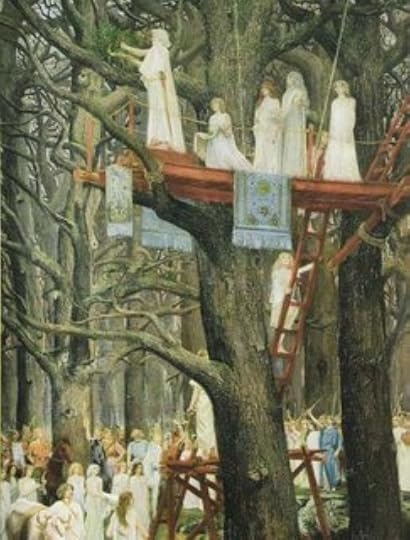 I am listening to the audiobooks of a wonderfully insightful and entertaining series of 8 novels by Kevin Hearne about the last surviving Druid in the 21st century. It’s called “The Iron Druid“. Although this immortal Druid inhabits a sexy 21 year old male body, he travels between realms of reality with his faithful Irish Wolfhound (Oberon), between whom telepathic communication is their common language.
I am listening to the audiobooks of a wonderfully insightful and entertaining series of 8 novels by Kevin Hearne about the last surviving Druid in the 21st century. It’s called “The Iron Druid“. Although this immortal Druid inhabits a sexy 21 year old male body, he travels between realms of reality with his faithful Irish Wolfhound (Oberon), between whom telepathic communication is their common language.
I have never read anything previously about Druids (‘oak-seer”), or the races of red-haired Celts, or the The Tuath(a) Dé Danann, a supernatural race in Irish mythology who serve a characters in these novels, along with a pantheon of gods from several planes of existence including vampires, witches, demons, fairies, ghouls, werewolves and many more manifestations of spirit in the magical “supernatural world” of wizardry and ancient wisdom.
Here is a short article from http://www.timelessmyths.com/celtic/
 “Most of what is know, about the ancient Celtic people in history, come from observances of classical Greek and Roman writers, as well as from archaeological evidences such as from the possessions of dead in burial sites and from shrines found throughout central and western Europe, as well as from the British Isles.
“Most of what is know, about the ancient Celtic people in history, come from observances of classical Greek and Roman writers, as well as from archaeological evidences such as from the possessions of dead in burial sites and from shrines found throughout central and western Europe, as well as from the British Isles.
To Julius Caesar, the druids were secretive but learned group, who enjoyed special privileges among the Celtic population. They did not have to fight in wars and they were exempted from paying taxes. They acted as judges in disputes and they presided over those who commit act of crime, as well as setting penalties. They could travel any where without hindrance from any tribes.
Though, there are many benefits of becoming a druid, it is still not an easy life. It may take over 20 years to learn the philosophy, divination, poetry, healing, religious rites and magic. And all this without committing anything to writing. The druids, or any Gaul for that matter, were fully aware of writing down their knowledge, but chose not to do so, because they preferred to rely on memories. For the druids, their pupils were required to exercise their mind.
The Gauls and the druids were not illiterate. Because of the trades between the Gauls and the Greek city of Massilia (modern Marseille) in southern France, the Gauls had earlier used Greek letters, mainly for trade purposes. The druids had never used the Greek writing to record their knowledge and customs. After Roman conquest of Gaul and Britain, later the Celts had adopted Roman letters for mainly commercial purposes. There are some inscriptions found in sacred sites, such as in shrines and sanctuaries.
Caesar observed that the Gauls were very religious, and they always wait for the druids to perform the necessary rituals or sacrifices. The Celts didn’t build any temples to their gods. The druids practiced their worship in the open air, such as at sacred groves or near sacred lakes.
According to Caesar and other classical writers, the Gauls believed in the souls being immortal, where it passed on to another body after death. In another words, they believed in reincarnation or eschatology.”
March 25, 2016
THE FIRE
 “The soul, being eternal, after death is like a caged bird that has been released. If it has been a long time in the body, and has become tame by many affairs and long habit, the soul will immediately take another body and once again become involved in the troubles of the world. The worst thing about old age is that the soul’s memory of the other world grows dim, while at the same time its attachment to things of this world becomes so strong that the soul tends to retain the form that it had in the body. But that soul which remains only a short time within a body, until liberated by the higher powers, quickly recovers its fire and goes on to higher things.”
“The soul, being eternal, after death is like a caged bird that has been released. If it has been a long time in the body, and has become tame by many affairs and long habit, the soul will immediately take another body and once again become involved in the troubles of the world. The worst thing about old age is that the soul’s memory of the other world grows dim, while at the same time its attachment to things of this world becomes so strong that the soul tends to retain the form that it had in the body. But that soul which remains only a short time within a body, until liberated by the higher powers, quickly recovers its fire and goes on to higher things.”
~ Plutarch (The Consolation, Moralia)
PLUTARCH (c. AD 46 – AD 120) was a Greek historian, biographer and essayist, known primarily for his Parallel Lives and Moralia.
Plutarch was born to a prominent family in the small town which lies approximately eighty kilometres east of Delphi, in the Greek region known as Boeotia. He lived most of his life at Chaeronea, and was initiated into the mysteries of the Greek god Apollo. However, his duties as the senior of the two priests of Apollo at the Oracle of Delphi (where he was responsible for interpreting the auguries of the Pythia) apparently occupied little of his time. He led an active social and civic life while producing an extensive body of writing, much of which is still extant.
Plutarch spent the last thirty years of his life serving as priest in Delphi. He thus connected part of his work with the sanctuary of Apollo, the processes of oracle giving and the personalities which lived or traveled there. One of his most important works is the “Why Pythia does not give oracles in verse”
YOUR STORY
 “You are what exists before all stories. You are what remains when the story is understood.”
“You are what exists before all stories. You are what remains when the story is understood.”~ Bryon Katie ~
(image: dusteramaranth)
March 24, 2016
THE GREAT SPONGE
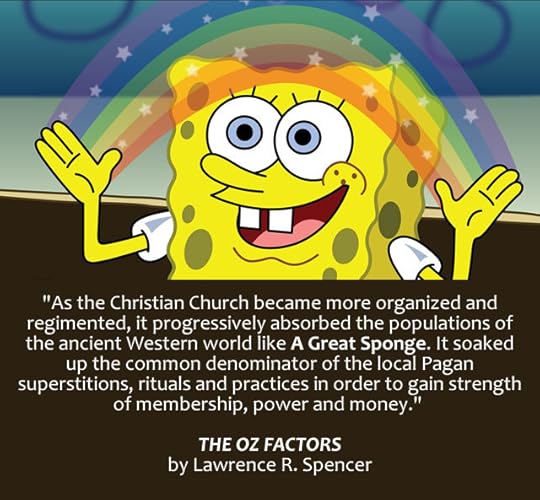 “As the Christian Church became more organized and regimented, it progressively absorbed the populations of the ancient Western world like A Great Sponge. It soaked up the common denominator of the local Pagan superstitions, rituals and practices in order to gain strength of membership, power and money.
“As the Christian Church became more organized and regimented, it progressively absorbed the populations of the ancient Western world like A Great Sponge. It soaked up the common denominator of the local Pagan superstitions, rituals and practices in order to gain strength of membership, power and money.
 Within several hundred years after the death of Jesus of Mary, the organizations of Christianity, founded by Paul and others, were no longer the persecuted disciples who endured prosecution, murder and martyrdom for the sake of their convictions. The Church controlled the political power that had once been the Roman State.
Within several hundred years after the death of Jesus of Mary, the organizations of Christianity, founded by Paul and others, were no longer the persecuted disciples who endured prosecution, murder and martyrdom for the sake of their convictions. The Church controlled the political power that had once been the Roman State.
The Pontifex Maximus of the Temple of Jupiter was the highest office of the Roman State Religion. This office, which was bought and paid for in cash money by the first Roman Emperor, Julius Caesar, was thereafter held by the Emperor of Rome. The original Roman state religion, though hundreds of years old, was based on the ancient pantheon of gods borrowed from their remote origins in the Veda and transmitted through Babylonian, Egyptian and Greek personifications.
By the time of the Emperor Aurelias in the third century, the state religion of the Roman Empire and the predominant god of the Roman Army was Mithra, who was considered to be the God of Battles, among other attributes. The origin of this religion is the Rig-Veda’s god Mithra, later called by a very Japanese sounding name, Ahura-Mazda.
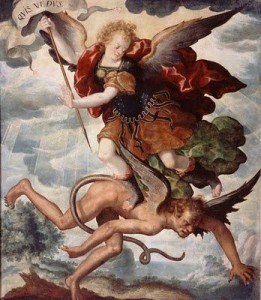 Mithraism* spread from India in various forms throughout the ancient world, including Iran, all of Persia, Asia Minor, Greece and throughout the Roman World. It was, itself, later merged with the Roman pantheon to become the official state religion of Rome and was spread around the known world by the travels of soldiers and along trade routes.
Mithraism* spread from India in various forms throughout the ancient world, including Iran, all of Persia, Asia Minor, Greece and throughout the Roman World. It was, itself, later merged with the Roman pantheon to become the official state religion of Rome and was spread around the known world by the travels of soldiers and along trade routes.
Many of the rites and beliefs of Mithraism, though not the deity itself, were absorbed into the practices of the Christian Church. These include the rite of baptism, the communion ritual using bread and water, robed priests and the symbol of the cross. The Pontifical hierarchy and the organization of the Temple of Jupiter, epiphany, the immaculate conception and virgin mother, the concepts of heaven and hell, priests called “fathers”, angels and Easter, to name a few, were also ideas borrowed from Mithraism.
The celebration of Christmas, held during the Winter Solstice to commemorate the birthday of Jesus was adapted from a variety of pagan cults. The celebration of the Roman holiday season of “Saturnalia”, for the god Saturn, was adapted to become Christmas in 336 AD. Saturnalia was a festival during which Roman slaves were given control of the household for one day each year. The festival was held between December 17th and 23rd during which families feasted together, slaves were given time off and presents were exchanged.
The evolution of the Christian Church is explored in many very interesting books. One of the most thoroughly documented histories of Western religions was written by the Oxford historian, Robin Lane Fox, ‘Pagans and Christians’, published by Knopf in 1986. Mr. Fox is marvelous in his ability to resurrect the souls of the pagan gods, obscured these thousands of years beneath tumbled down temples desecrated by jealous religious zealots. One can only speculate on the revenge those noble gods may have wrought on succeeding generations of those who have trampled the Spirit of gods and Man alike in the wake of soulless religious rhetoric.
EMPEROR JUSTINIAN
Over time, the practices and, to a large degree, the philosophy of the Christian Church were irrevocably altered by too close an alliance with the materialistic business of power politics.
The consolidation of the Church under the control of a totalitarian Roman State became state law. By the end of the fourth century, Pagan worship, both public and private, was prohibited with severe penalties. All Pagan temples were closed or destroyed. The institution of Christianity became the very same political entity which had persecuted it in its infancy.
In the fifth century, Pagans were barred from any community service. In 529 AD, Roman Emperor Justinian closed the thousand year old Platonic Academy in Athens and ordered all Pagans to become Christians. Any who refused were exiled and their property confiscated. Competitive religions such as Judaism, Samaritanism, Zoroastrianism and Manicheism were violently persecuted.
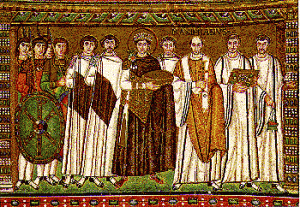 By Justinian’s time, the enormous growth of Church property and personnel caused a corresponding growth in the power and wealth of the Church hierarchy of bishops. They came to be part of the same class as the highest government officials, including senators.
By Justinian’s time, the enormous growth of Church property and personnel caused a corresponding growth in the power and wealth of the Church hierarchy of bishops. They came to be part of the same class as the highest government officials, including senators.
A good-sized cathedral would employ 50 to 100 clergy. The election of Church officials was violently contested; one election in Rome left 137 dead in one day’s fighting. We are fortunate that modern day churches no longer employ so many priests with such covetous zeal!
By the year 543 AD, the writings of Origen, in keeping with the spiritual concepts of Christ and of the Greek philosophers that included the concept of past lives, had become politically “inconvenient”. In 553 AD at the Fifth Ecumenical Council at Constantinople, the Byzantine Emperor Justinian decided to OUTLAW THE IDEA OF THE PRE-EXISTENCE OF SOULS! He officially cursed the doctrine and vowed to excommunicate anyone who believed in Origin’s teachings. In addition, these ideas were banned from all subsequent publications of the Bible.
Thereafter, the increase in poverty, caused by religious suppression and government taxation, led to a decline throughout the Roman Empire.
The era became characterized by a sort of mass paranoia of superstition, fanaticism and violence regarding incomprehensible religious formulas. “Demonic possession” grew to epidemic proportions; every church employed large staffs of exorcists. Magic became the most important branch of philosophy. Medicine was overrun with recipes for amulets which were later replaced by the relics of holy men, especially martyrs. Saints of the Church assumed the functions once filled by the Pagan gods to send rain, avert storms, drive away pestilence, and so forth. The most important cult became that of Mary, the all-holy Mother of God.
The Dark Ages had begun.
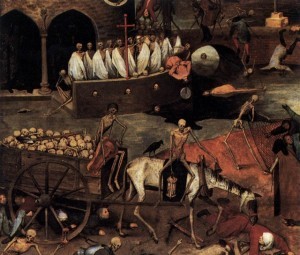 Was it a coincidence that the worst outbreak of plague in history occurred during Justinian’s rule? The plague spread from Palestine, the very home of the Christ, and struck the Roman capital of Byzantium in the spring of 542 AD. The mortality rate in the city rapidly rose to 10,000 deaths a day. So many were the deaths that graves could not be dug fast enough to dispose of the rotting bodies. Roofs were taken off the towers of forts, the towers filled with corpses and the roof replaced. Ships were loaded with the dead, rowed out to sea and abandoned! And, if the plague weren’t enough, the entire world experienced disastrous earthquakes during that time.
Was it a coincidence that the worst outbreak of plague in history occurred during Justinian’s rule? The plague spread from Palestine, the very home of the Christ, and struck the Roman capital of Byzantium in the spring of 542 AD. The mortality rate in the city rapidly rose to 10,000 deaths a day. So many were the deaths that graves could not be dug fast enough to dispose of the rotting bodies. Roofs were taken off the towers of forts, the towers filled with corpses and the roof replaced. Ships were loaded with the dead, rowed out to sea and abandoned! And, if the plague weren’t enough, the entire world experienced disastrous earthquakes during that time.
Such a series of events might persuade one to consider the possibility that there might be such a thing as the wrath of God!”
* NOTE: The religion of Mithraism, with its central theme of a dualistic battle between good and evil, was popular in the Roman Empire. It was especially favored by the military. Michael, like Mithras, is also connected to those in uniform, being considered the patron of police officers and soldiers.
~ excerpt from THE OZ FACTORS
by Lawrence R. Spencer
March 22, 2016
CATS AND MICE AND GODLESS PARASITES
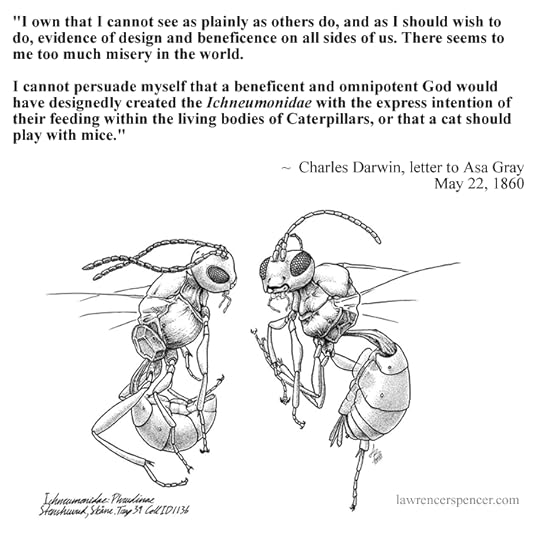 “I own that I cannot see as plainly as others do, and as I should wish to do, evidence of design and beneficence on all sides of us. There seems to me too much misery in the world. I cannot persuade myself that a beneficent and omnipotent God would have designedly created the Ichneumonidae with the express intention of their feeding within the living bodies of Caterpillars, or that a cat should play with mice.”
“I own that I cannot see as plainly as others do, and as I should wish to do, evidence of design and beneficence on all sides of us. There seems to me too much misery in the world. I cannot persuade myself that a beneficent and omnipotent God would have designedly created the Ichneumonidae with the express intention of their feeding within the living bodies of Caterpillars, or that a cat should play with mice.”
~ Charles Darwin, letter to Asa Gray, May 22, 1860
__________________________________
 Ichneumonidae is a family of parasitic wasps, and one of my particular research interests. If you’ve never heard of a parasitic wasp before, think chest-burster from Alien, but for insects. A more scientific definition is that parasitoid wasps lay their eggs inside or on top of other insects; those eggs then grow and develop by feeding on their host’s tissue, resulting in the eventual death of the host. Estimates of the total species range from 60,000 to over 100,000.
Ichneumonidae is a family of parasitic wasps, and one of my particular research interests. If you’ve never heard of a parasitic wasp before, think chest-burster from Alien, but for insects. A more scientific definition is that parasitoid wasps lay their eggs inside or on top of other insects; those eggs then grow and develop by feeding on their host’s tissue, resulting in the eventual death of the host. Estimates of the total species range from 60,000 to over 100,000.






